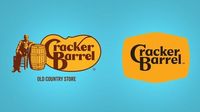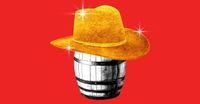Cracker Barrel, the popular Southern-style restaurant chain, found itself at the center of a branding storm this past week, as a well-intentioned logo redesign collided headlong with the fierce loyalty—and vocal opinions—of its customer base. The saga, which erupted in late August 2025, has become a case study in the perils of tinkering with a legacy brand, especially in a politically charged era where even a logo can become a lightning rod.
At the heart of the controversy was Cracker Barrel’s decision to swap its iconic “Old Timer” logo—featuring Uncle Herschel, an overall-clad gentleman leaning on a barrel—for a much simpler design: the company’s name in brown letters against a gold background. The change, rolled out quietly in a press release about new fall menu items on August 18, 2025, was intended as part of a broader transformation plan under new CEO Julie Felss Masino. But the reaction was anything but quiet.
Customer traffic at Cracker Barrel had been down 16% compared to 2019, according to a report shared with investors in 2024. The company, which operates nearly 660 restaurants across 43 states, had seen its once-booming growth stall. In 2024, revenue crept up less than 1% to $3.5 billion, while net income fell sharply to $40.9 million from $99 million the previous year. Masino, who joined Cracker Barrel in July 2023 after stints at Taco Bell and Starbucks, was brought in to spark innovation and win back diners. She introduced new menu items—like Hashbrown Casserole Shepherd’s Pie—and began remodeling the chain’s famously dark, antique-filled dining rooms with lighter walls and more comfortable seating.
These changes seemed to be working. By the fiscal third quarter ending May 2, 2025, Cracker Barrel notched its fourth consecutive quarter of same-store sales growth, a key metric in the restaurant industry. But the logo redesign, meant to signal a fresh start, quickly became a flashpoint.
Branding experts were divided. Richard Wilke, a former executive at Lippincott who helped lead rebrands for Delta Air Lines and Walmart, noted that the original logo was “too detailed and fussy for the digital age,” but he also called the new design “lacking in character.” The rollout itself seemed almost an afterthought, buried in the fourth paragraph of a press release. “The logo change was almost a natural conclusion to this multi-year transformation,” Wilke told the Associated Press, referencing Walmart’s more gradual approach to rebranding in 2008. “I suspect that if we did it in the same sequence as Cracker Barrel, we would have gotten the same noise.”
But the noise was deafening. Customers, especially long-time fans, took to social media to voice their dismay. “I don’t like the changes. I mean it’s always been Cracker Barrel like it is, so I’d like for it to stay like it is,” Sid Leist, a customer in Vicksburg, Mississippi, told the Associated Press. According to a YouGov survey of 1,000 adults, a whopping 76% preferred the old logo to the new one.
The backlash quickly gained a political edge. MAGA influencers lambasted the new logo as “woke,” and President Donald Trump himself weighed in on Truth Social on August 27, 2025, urging Cracker Barrel to “go back to the old logo, admit a mistake based on customer response (the ultimate Poll), and manage the company better than ever before.” Later that day, Trump congratulated the company for reverting to its original branding, writing, “All of your fans very much appreciate it. Good luck into the future. Make lots of money and, most importantly, make your customers happy again!”
Faced with this groundswell of criticism, Cracker Barrel’s leadership acted swiftly. By the evening of August 27, 2025, the company announced on social media that it would abandon the new design and keep the beloved “Old Timer” logo. “We said we would listen, and we have. Our new logo is going away and our ‘Old Timer’ will remain,” the company posted, adding, “We thank our guests for sharing your voices and love for Cracker Barrel.” The company also reassured customers that Uncle Herschel would remain a fixture on menus, road signs, and in its country stores. “He’s not going anywhere—he’s family,” the company declared.
The market responded almost instantly. Cracker Barrel’s stock jumped more than 8% on August 27, closing at $62.33 per share—higher than its pre-announcement price on August 15. The reversal helped erase earlier market losses and sent a clear message about the power of brand loyalty.
Branding and marketing professionals were quick to analyze what went wrong. David E. Johnson, CEO of Strategic Vision PR Group, told CBS MoneyWatch, “From a branding perspective, it’s basically a flop. What they did wrong is they went against their brand story, which was the old logo, that reflected the southern, whimsical atmosphere in the stores.” Nick Yeonakis, a franchise consultant, added that the original image was “a throwback to a simpler time that was about home cooking.” The new logo, stripped of its folksy imagery, struck many as “sterile” and “soulless.”
Yet, some experts argue that Cracker Barrel’s intention to modernize wasn’t misplaced. Tom Murphy, a professor at Clark University’s School of Business, called the decision to restore the old logo “a positive course correction” and suggested the company should continue refreshing its stores to appeal to younger customers—without abandoning its heritage. “This gives them an opportunity to reinforce the fact that they are not moving away from their brand purpose or their heritage,” Murphy said.
The episode also underscores the challenges legacy brands face in today’s polarized environment. “It’s very hard to be a brand for everybody today because we are so polarized, and people look at things through a political lens even if there is no political intent,” Carreen Winters, president of reputation at MikeWorldWide, told CBS MoneyWatch. “When you are a legacy brand, it’s really important to understand who your core is, and to not do anything to alienate them while cultivating your future or next generation customer.”
Wilke, the branding consultant, lamented the politicization of what should be business decisions. “This isn’t a political story,” he said. “If politicians now turn every company logo design update into a debate about being ‘woke’ or ‘anti-woke,’ we are headed into a damaging new era for corporate branding.”
In the end, the Cracker Barrel logo saga serves as a reminder that for some companies, heritage isn’t just a marketing tool—it’s the very foundation of their relationship with customers. As Cracker Barrel looks to the future, the challenge will be finding ways to evolve without losing sight of the values and symbols that made it an American institution in the first place.

